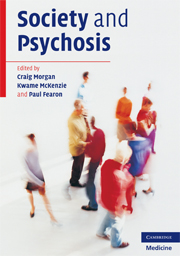Book contents
- Frontmatter
- Contents
- Contributors
- Acknowledgements
- 1 Introduction
- 2 Climate change in psychiatry: periodic fluctuations or terminal trend?
- Part I Theoretical and conceptual foundations
- Part II Social factors and the onset of psychosis
- Part III Social factors and the outcome of psychosis
- 11 Social factors as a basis for treatment
- 12 Public attitudes, stigma and discrimination against people with mental illness
- 13 Outcomes elsewhere: course of psychosis in ‘other cultures’
- Part IV Models and conclusions
- Index
- References
13 - Outcomes elsewhere: course of psychosis in ‘other cultures’
from Part III - Social factors and the outcome of psychosis
Published online by Cambridge University Press: 07 December 2009
- Frontmatter
- Contents
- Contributors
- Acknowledgements
- 1 Introduction
- 2 Climate change in psychiatry: periodic fluctuations or terminal trend?
- Part I Theoretical and conceptual foundations
- Part II Social factors and the onset of psychosis
- Part III Social factors and the outcome of psychosis
- 11 Social factors as a basis for treatment
- 12 Public attitudes, stigma and discrimination against people with mental illness
- 13 Outcomes elsewhere: course of psychosis in ‘other cultures’
- Part IV Models and conclusions
- Index
- References
Summary
Introduction
In the mid-1970s, a fledgling anthropologist and her family landed in Dublin, ready to tackle the runes and riddles of ‘Gaelic sexuality’. Fortune had other plans. Within days of her arrival, a chance meeting with a psychiatrist convinced Nancy Scheper-Hughes to try her hand at a more consequential topic, runaway rates of schizophrenia in rural Ireland. Settling down in a seafaring village on the Dingle peninsula, she set out (as she would later put it) to ‘study madness among bachelor farmers as a projection of cultural themes’ (Kreisler, 1999). Drawing on Bateson's notion of pathogenic paradoxical communication snares (Bateson et al., 1956), she made good on the dare. Hospitalised Patrick was one of many last-born sons ‘crippled by his parents’ double-binding attempts' to keep him in reserve (single, at home, on call for their old age). Commonplace in this ‘demoralised, dying, western village’ (Scheper-Hughes, 1979, p. 190), these desperate parental gambits were late expressions of ‘the breakdown of traditional patterns of Irish familialism’. Patrick's plaintive ‘I am their dead son’ was less psychotic delusion than dreary, de facto truth.
When Saints, Scholars and Schizophrenics was published in 1979, it caused a sensation, one that has yet to fade entirely. Alternately hailed and denounced as breakthrough ethnography and heart-breaking exposé, its place in medical anthropology's canon was quickly secured. Complaints about its inaccuracies and betrayals aside, the book was plagued by a more fundamental methodological difficulty.
Keywords
- Type
- Chapter
- Information
- Society and Psychosis , pp. 198 - 216Publisher: Cambridge University PressPrint publication year: 2008
References
- 14
- Cited by



